Read Reviews
The Best Heated Electric Propagators
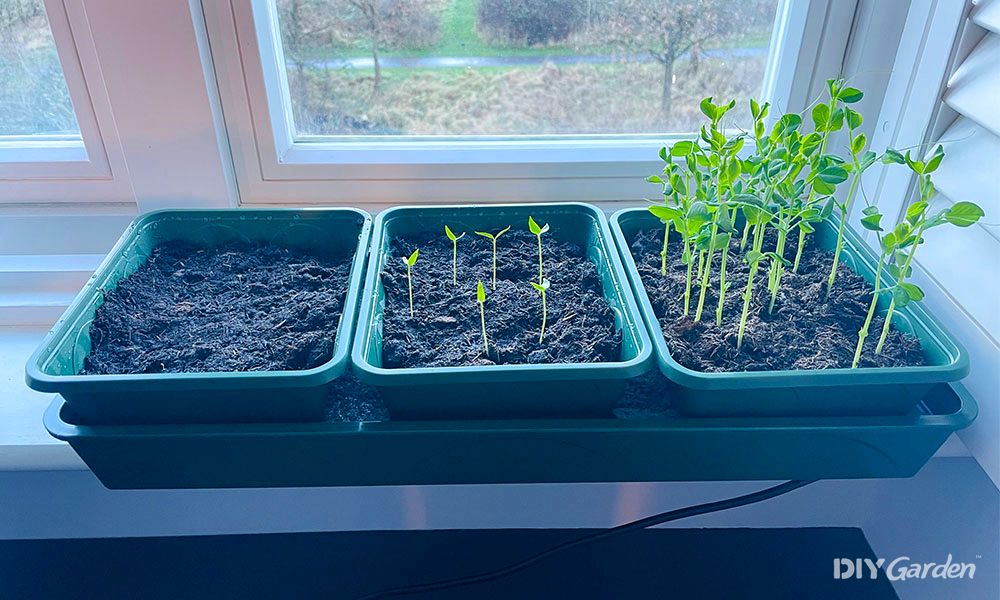
-
Best value propagator - Garland Super 7 Electric Heated Windowsill Propagator
-
Best heated electric propagator - EarlyGrow 3-Bay Heated Electric Propagator
-
Best for number of cells - Britten & James 7-in-1 Mini Heated Propagator
-
Best high temperature - Garland Fab4 Electric Heated Propagator
-
Best large propagator - Stewart Essentials Electric Propagator
Heated Electric Propagator Reviews
1. Garland Super 7 Electric Heated Windowsill Propagator
Best value propagator
- Simple to use - just plug it in and turn it on
- Highly effective when it comes to starting seedling growth
- A good size for most window sills, with a slimline design
- 7 mini propagators included so can be used for planting a variety of seeds
- Raises temperature inside by around 8°C
- Although simple to use, there are no controls and the heat is only increased by 8°C - so this propagator still needs to be kept inside on a warm windowsill
- The clear plastic lid isn’t very durable and needs to be handled with care
- There is no indicator light so it’s easy to accidentally leave it on
- Number of 'Cells'
- 7
- Power
- 13 W
- Ventilation
- Yes
- Design
- 4.5
- Performance
- 5
- Features
- 4.5
- Value for Money
- 5
With seven individually-vented cells and a reasonable price tag, this Garland Super7 Electric Heated Windowsill Propagator offers good value for money. Despite having seven cells, it has a compact design enabling you to grow germinate multiple seed varieties in one go. Very handy!
Measuring just 18.5cm wide, this propagator easily fits onto the average window ledge. The 76cm length means you can still fit ample seeds into this unit. The roof is high enough to allow seedlings to grow around 5cm, and the trays are also sufficiently deep to offer enough space for roots to fully develop. As a result, when it comes to planting seedlings out, they are already well established.
Thanks to the seven separate cells, you can plant different types of seeds in each one if you wish, and each cell has its own vent to control the temperature according to the different plant.
This propagator is certainly very effective, prompting seeds to germinate often in a matter of days, or maybe a week at most. It encourages germination in a wide range of plants from tomatoes, to chillies, to flowers like achillea.
Even in colder months like February, this propagator can kick start the growth of lettuce seeds and peas in a matter of days.
Whilst this propagator does heat well, unfortunately there is no thermostat or temperature control. However, it seems to work effectively without the need for any of these added features. In general, the temperature inside the propagator rises by around 8°C and maintains a consistent heat.
This propagator comes with a power cord, although at 2m it may be a little short. Using it with an extension cable may be necessary.
Overall, this is one of the best heated electric propagators if you’re after value for money and it fits well into smaller spaces!
Did you find this review helpful?
2. EarlyGrow 3-Bay Heated Electric Propagator[ SAVE 4% ]
Best heated electric propagator
- Highly effective when it comes to starting seedling growth
- Compact unit with a slimline design that fits onto most windowsills
- Simple to use, with adjustable ventilation to control humidity and air flow
- Robust and sturdy with a shatter resistant lid that’s made to last
- I would liked to have seen a light to indicate whether the unit is on or off
- Even with the adjustable ventilation, condensation still builds up inside the lids
- Number of 'Cells'
- 3
- Power
- 12 W
- Ventilation
- Yes
- Design
- 5
- Performance
- 5
- Features
- 4
- Value for Money
- 4
How I Tested
There was only one way to test the EarlyGrow 3-Bay Heated Electric Propagator! I took my kids to our local garden centre, where they chose a small variety of fruit and vegetable seeds they wanted to grow. I tried to guide them within the suggested ‘germination months’, but they were naturally drawn to the strawberries! Hey, might as well give it a try right?! So we planted strawberry, peas, and giant pepper seeds.
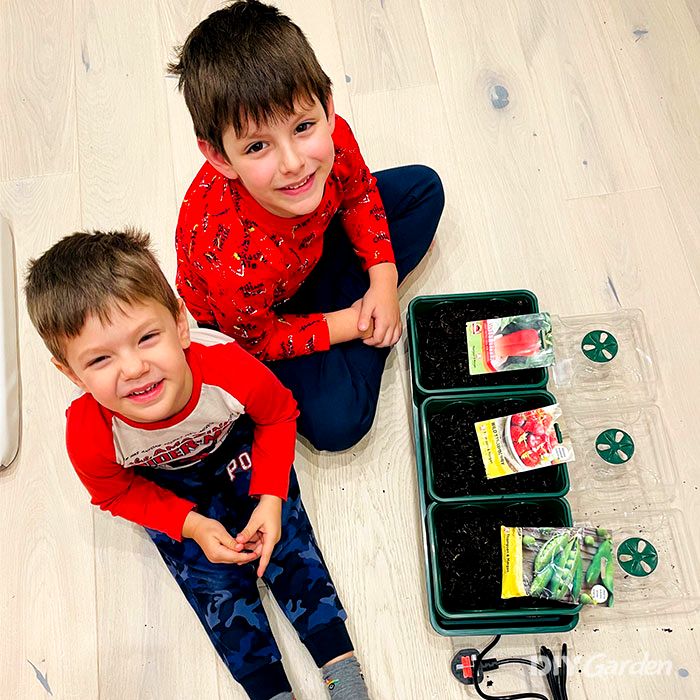
After each cell was filled with compost, and the seeds were carefully spaced out, it was time to set up the propagator. Firstly, you have to fill the bottom ‘reservoir’ with water. Then the soft material mesh wraps around the base, so that the edges drape into the water. This way it absorbs and draws the moisture up. Once the whole thing becomes saturated, the water slowly evaporates into the cells sitting on top, and therefore waters your soil. Clever hey?!
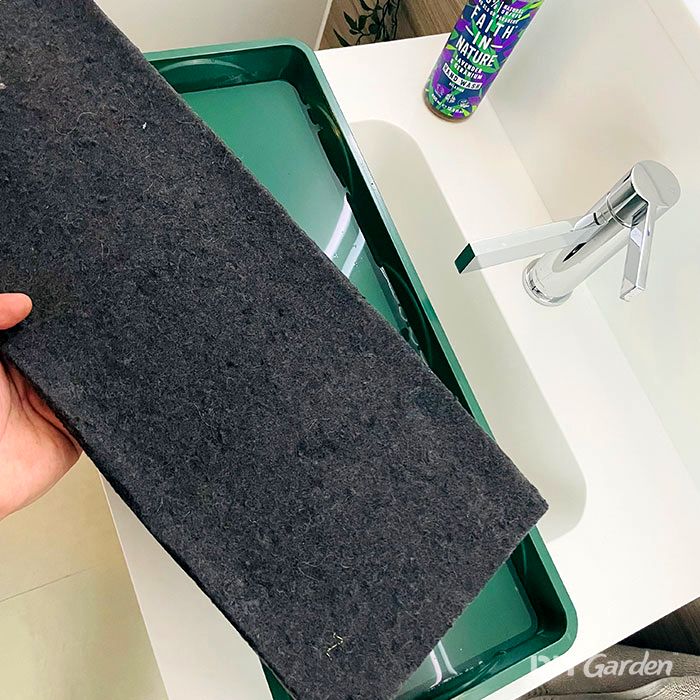
Finally, I carefully placed the propagator on my windowsill (where there is plenty of light) and plugged it in. Me and the kids then excitedly checked daily to spot any signs of life! You can read more about how quickly germination took place in my video review of the EarlyGrow Propagator below.

The Results
The EarlyGrow 3-Bay Heated Electric Propagator is impressively simple to use, yet cleverly designed. It’s got three well-sized “cells” that sit on top of a reservoir in the base of the unit. Fill it with water, set up the absorbent material over the base, turn it on and you’re good to go!
My testing took place in early January (just to give a bit of seasonal context) and within 3 days the peas had started to germinate. After a week they were really going for it, and it was time to remove the lid of the cell. The giant peppers took 8 days to pop their heads through, and after two weeks we were even able to see a few strawberry stems shooting up!
Obviously, the germination time is entirely dependent on the plant or vegetable variety, but it’s just a good example that the EarlyGrow is very capable of generating the right conditions for seed germination – which is of course the most important factor here.

A couple of points worth mentioning that perhaps aren’t so positive. It would have been nice to have some kind of indicator light on the unit so you know when it’s on or off. Obviously the heat it generates is very subtle, but I still found myself putting my hand on the side of the unit to check it was on when I first set it up. Not massively important, but it would be a ‘nice-to-have’ feature.
Also, the cells can be prone to a condensation build up, even when the vents are open. I suppose though this is just what happens when you mildly heat something and contain it! Over time I’ve learnt that by switching the unit off and giving the cells a bit of breather everything clears up nicely.
So in summary, where do I stand on the EarlyGrow 3-Bay Propagator? I love it! It functions brilliantly, it fits perfectly on my windowsill and it provides a great educational resource for the kids! If you’re looking for a well-made, well-sized unit, in my opinion, this will be the best heated electric propagator for most users.
Did you find this review helpful?
3. Britten & James 7-in-1 Mini Heated Propagator
Best for number of cells
- Domed lids are high enough to accommodate plant labels
- 7 mini propagators included so can be used to plant a variety of seeds
- Heat produced is even and reliable across the 7 mini trays
- Adjustable ventilation for each tray
- Not thermostatically controlled and no timer, so you’ll need to remember to switch it off
- Although they work well, the vents are a little delicate and the lids should be handled with care
- Trays are very small, measuring just 14cm x 10cm at the base
- Number of 'Cells'
- 7
- Power
- 13W
- Ventilation
- Yes
- Design
- 4.5
- Performance
- 4
- Features
- 4
- Value for Money
- 4.5
The Britten & James 7-in-1 Mini Heated Propagator has seven mini seed trays and can be used to plant a variety of seeds if required. This is especially useful if the seeds have different germination rates. You’ll be able to remove and replant one set of seedlings, without disturbing the others.
Measuring just 76 x 18.4 x 15.2cm, this propagator fits most average windowsills. Each tray comes with a transparent lid so you can easily monitor the progress of your seedlings, while the air flow and temperature can be controlled using the red vents on each lid.
The trays are very small, measuring just 14 x 7cm at the base. This makes them suitable for those who want to grow a small amount of each plant, although the trays are still deep enough for your plants to develop strong roots.
In terms of performance, this propagator can be used to grow a wide variety of seeds. It comes with a 13W carbon fibre element that provides an even heat distribution, raising the temperature by around 8°C. Having said that, it’s still best installed on a sunny windowsill if you’re growing plants that prefer a lot of warmth.
Although this propagator doesn’t have a timer or thermostat, the growing conditions can be controlled to an extent using the air vents. It’s also incredibly simple to use, while the heat produced is even across the 7 trays.
The only downside to note is that the mains cable may be a little short at 132cm. Some people may need to purchase an extension lead separately. However, this is a relatively minor issue, and overall this propagator is one of the best seven-cell options.
Did you find this review helpful?
4. Garland Fab4 Electric Heated Propagator
Best high temperature
- Warmer than others on the market, raising the temperature around 10°C - suitable for seeds that prefer a warmer climate
- Simple to use - simply plug in and turn on
- Comes with 4 individual containers for planting different seeds
- Produces good results thanks to the warm temperature
- Ventilation sliders can feel a little loose
- Lids are not overly secure and very easy to knock off accidentally
- Number of 'Cells'
- 4
- Power
- 10W
- Ventilation
- Yes
- Design
- 4.5
- Performance
- 5
- Features
- 4
- Value for Money
- 5
The Garland Fab4 Electric Heated Propagator is a great option for those requiring a little more warmth as it boosts the soil temperature by up to 10°C. It’s slightly warmer than others on the market, producing good results especially for seeds that require a hotter climate. Unlike others I’ve mentioned, there’s no need to place it in a sunny spot.
This propagator is made up of 4 individual seed trays, as well as a heated base. While it requires a little more space than other units I’ve recommended, measuring 39 x 25 x 16cm, it still fits easily on most average window sills. Each tray measures 8.5 x 15.5cm, while the height of the lid is 8cm. This allows seedlings to grow tall and develop strong roots before replanting.
As I’ve already mentioned, this propagator is high performing, boosting the temperature by 8-10°C. The heat distributed is evenly spread across the base thanks to the reliable carbon fibre element, while the growing conditions can be controlled using individual vents across the 4 seed trays.
Extra features on this propagator are very limited. There is no thermostat and no timer, although a timer can be separately hooked up. Many users found that it got too hot for some seedlings, so I’d recommend keeping an eye on things for the first few days.
However, for its reliability, warmth and simplicity, this propagator remains a very good value option for those without a sunny window ledge.
Did you find this review helpful?
5. Stewart Essentials Electric Propagator[ SAVE 27% ]
Best large propagator
- Has a lot of internal space - can fit 2 x 24-pot seed trays
- The adjustable ventilation panels offer relatively easy temperature and humidity control
- The 28 cm height provides enough room for seedling to fully establish before needing to be moved on
- Simple to use with easily adjustable air vents
- The plastic lid can be a bit delicate - it needs to be handled carefully to avoid damage
- The cable is fairly short so this propagator will need to be placed near a plug socket or used with an extension
- There is no adjustable temperature control, just one set temperature
- Due to its wide, square design, it's too big for most windowsills
- There's only one heating space, so different seeds must be placed in the same conditions as each other
- Number of 'Cells'
- 1
- Power
- 22 W
- Ventilation
- Yes
- Design
- 4
- Performance
- 4
- Features
- 4
- Value for Money
- 4.5
If you want to ensure a high yield of germinated seedlings, this 22W Stewart P035B Electric Propagator allows you to plant up to 144 seeds at a time, which can result in germinating at least 50 plants in one ‘round’.
Given that propagation can be a little hit and miss, having space in this large 52 x 42.5 x 28cm unit for so many seeds is one way to help increase the chances of success!
The design itself is very simple. This unit consists of a heated tray with a ventilated plastic lid – you supply your own trays/pots, but it can fit 2 x 24-pot plant trays, so that gives you a good idea of its size in practical terms.
There’s only one open heating space, so you’re not restricted by smaller ‘cells’. The only real downside to this is that seeds can’t be individually ventilated. The plastic lid has two vents, which can be opened or closed to help regulate the temperature inside the propagator.
In terms of space, there’s plenty of room for seedlings to grow, considering the height of the unit is 28cm. If you’ve made the mistake of planting out germinated seeds too quickly in the past, they’ll have plenty of space to germinate and mature here.
Of course, as this is a larger unit, it may not fit on a windowsill. Instead, it will need to be placed on a table, desk or worktop if you’re using it indoors.
This tray heats very evenly, but unfortunately there is no thermostatic control. Taking the temperature readings and opening the vents, or even turning the unit off for a brief time, is the only way to control the heat. However, most users find this level of control more than enough for most seedlings, and appreciate its ease of use.
For such a large propagator, the price tag is very reasonable. If you’re looking for a simple to use large propagator with a high capacity, the Stewart P035B Electric Propagator is one of my top choices.
Did you find this review helpful?
Product Tester
Compare Product Features
Use the dropdown to sort the table by the feature you want to see.
Garland Super 7 Electric Heated Windowsill Propagator
- 4.8
- 7
- 13 W
- Yes
EarlyGrow 3-Bay Heated Electric Propagator
- 4.5
- 3
- 12 W
- Yes
Britten & James 7-in-1 Mini Heated Propagator
- 4.3
- 7
- 13W
- Yes
Garland Fab4 Electric Heated Propagator
- 4.6
- 4
- 10W
- Yes
Stewart Essentials Electric Propagator
- 4.1
- 1
- 22 W
- Yes
How to Choose The Best Heated Propagator
Getting your seeds off to a great start in life is made a lot easier (and quicker) with the help of a heated propagator.
Whether you are looking to germinate seeds early, or have been struggling to get seedlings to thrive, a heated propagator can provide very beneficial surroundings for young plants (for more information on growing different plants, check out our extensive collection of plant growing guides).
A heated propagator creates an environment that’s just a few degrees above air temperature, forming conditions that help many seeds to germinate. The best part is that they cost just a few pence a day to run.
If you want to buy a heated propagator, the following information should help clear up any doubts or questions you may have:
Choosing the Right Size
The size of propagator you should buy will depend on the space you have available, and how many seeds you want to propagate.
Take a look at the product’s dimensions and match them up with the space you have available – propagators come in a range of sizes, so you’ll find one to fit your space with a bit of searching!
To give an idea of size: there are units that are small enough to fit onto windowsills, whilst others will need to be placed on a table/worktop/greenhouse shelf.
Large, one-cell units that measure around 52 x 45 cm can be used to try to germinate around 140 seeds. They’re often big enough to fit 2 x 24-pot seed trays, and if you get 3 seeds in each pot, this can mean the potential to plant 144 seeds.
Some smaller units have individual ‘cells’ for each pot so you don’t have as much free range with how many different seeds you can plant at a time.
For example, in the above list, there are some seven-cell propagators, which would make it possible to plant around 21 seeds (if you planted three seeds in each cell). However, the good thing with individual-cell propagators like this is that you can have better control over the temperature in each cell.
Having an idea about the length of the propagator’s mains cable before purchasing is also a good plan. Some propagators have short cables of 1 m, whilst others are slightly longer at between 2 and 3 m. Depending on where you have a power outlet, either in the house or greenhouse, you may have to use an extension cable.
Lid Height for Better Growth
The lid height will dictate how long you can keep your produce growing in the propagator – if the plants start pushing the ceiling, they’ll have to be taken out.
Generally, a height of around 20 cm will allow enough space for your seedlings to establish properly, giving them enough time to grow good roots and 3 – 4 full leaves before having to transplant them.
The tallest propagator featured on this page is 28 cm. This sort of height will give a lot of flexibility on the types of seeds and cuttings you can propagate in the unit.
Number of Compartments
The number of compartments will allow you to grow several types of different types of seeds; you can adjust the soil type and environment to suit the individual seed.
Most standard propagators either come with on large seed tray, or one larger tray and a few separate smaller trays. These may be contained under the same roof, or in individual ‘cells’.
If there are separate trays, or there’s enough space to use your own pots, you can have a lot more flexibility on using different compost types and planting different seeds.
Having a propagator with separate ‘cells’ will mean you can choose to ventilate certain cells and not others which allows you to adjust the environment to the individual seed.
For example, the Garland Super 7 Propagator is one of the best heated electric propagators for catering to different seeds; it has seven different pods and each one has its own ventilation. These type of set up allows you to keep some seeds cooler than others, all whilst using the same propagator.
READ NEXT: The Best LED Grow Lights
The Effect on Your Energy Bill
The idea of adding a propagator to your house might seem daunting – doesn’t it cost a lot of money to have a heat source on for a long time?
Electric propagators can range in wattage, and the size of the propagator will also affect how much power you need. The wattage determines the cost of running it.
Generally, you want to be keeping the temperature of the soil inside the propagator at around 10 – 15°C depending on the seed. If there’s no thermostat or temperature control, you can use a thermometer to check the temperature and make sure the propagator isn’t on, using power, unnecessarily.
You can buy propagators that range anywhere from 8 – 100 W.
A propagator of between 13 – 22 W is generally sufficient for home use.
Calculating Running Costs
First, you will need to know how much your energy provider charges per kilowatt-hour. Let’s say they charge 14p per kWh (a relatively standard rate in the UK).
Then, you’ll need to multiply the wattage of the propagator by the number of hours it’ll be used each day. Divide this number by 1000 and multiply by 14 (or your specific kWh rate).
For example, if you run a propagator of 100 W for an hour, at this rate, it will cost you 1.4p for that hour. A propagator of 50 W will cost 0.7p for an hour. And a propagator of 22 W will cost you 0.3 p per hour.
As you can see, at these low wattages, keeping a propagator running is quite affordable.
Plus, if you get a propagator with a thermostat, it will regulate the temperature and save energy by turning off when it reaches a certain temperature.
A lower-wattage propagator will heat up more slowly, but cost less to run, than a higher-wattage unit.
A high-wattage propagator will heat up quickly; however, if there’s no thermostat then you’ll have to be around to turn it off, to stop it from heating unnecessarily and using up too much power.
Heated Electric Propagator FAQs
Most seeds germinate more effectively with some base heat. However, a heated propagator is particularly useful for plants that are usually grown in warmer climates as these generally need warmer temperatures to germinate.
If you are planning to grow tomatoes, chillies, peppers, aubergines, cucumber or melons then an electric propagator will be a worthwhile investment. Heated propagators are also useful for seeds which require a long growing season as they enable you to get a head start and maintain a consistently warm temperature.
An electric propagator is very simple to use. Once you have planted your seeds in the trays or pots and watered them, simply put them into the propagator and turn it on.
You will probably not notice a great deal of warmth in the unit, however, you will see some condensation that will show you the unit is doing its job. If your unit has a capillary mat, then wet this under the tap and put it at in the base before putting your seeds in.
You can adjust the ventilation in your electric propagator as necessary, but bear in mind that the unit will dry out more quickly when the vents are open. Once the seeds have germinated and are beginning to grow, you can either remove them from the propagator or just unplug the unit if all the seeds have germinated. You can also increase the ventilation at this stage to gradually acclimatise the seedlings.
Place your propagator somewhere warm and sunny, but ideally away from direct sunlight. A sunny windowsill tends to be a good option.
If your propagator won’t fit on a windowsill, placing it on a table, desk or counter-top in a room that gets a lot of sunlight is another good choice.
Bear in mind the length of the power cable when placing your propagator – you may need to use an extension cord if there is not a mains socket nearby.
Remember to turn your propagator regularly, to encourage your seedlings to grow straight up and not bend towards the sunlight.
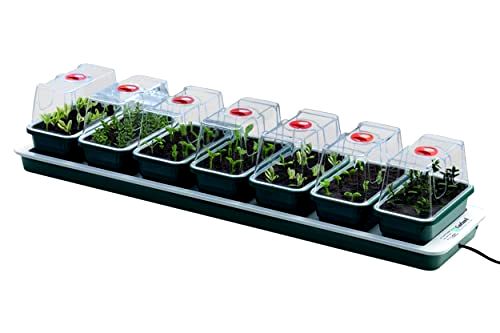
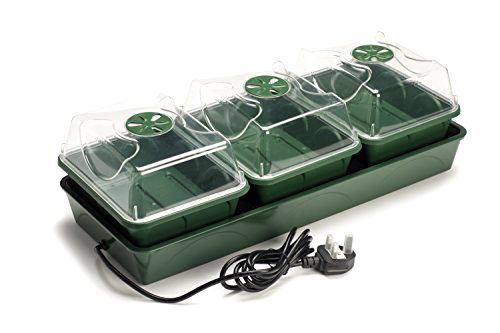

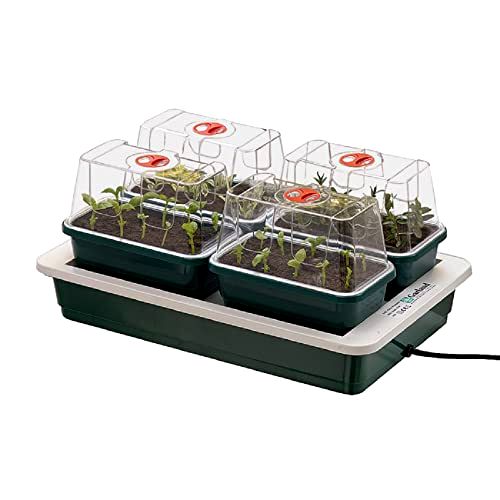
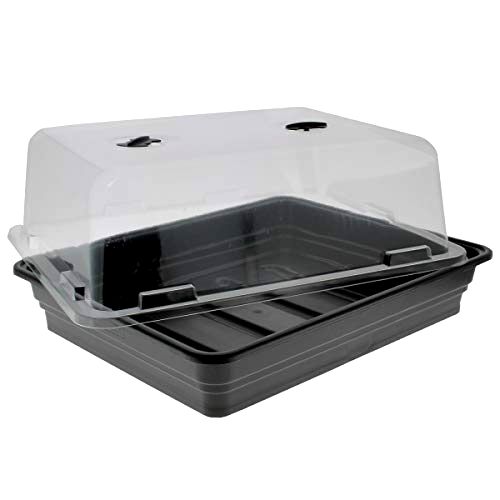

Share